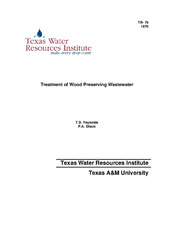| dc.creator | Reynolds, T. D. | |
| dc.creator | Shack, P. A. | |
| dc.date.accessioned | 2011-07-01T20:08:06Z | |
| dc.date.available | 2011-07-01T20:08:06Z | |
| dc.date.issued | 1976-10 | |
| dc.identifier.uri | https://hdl.handle.net/1969.1/94922 | |
| dc.description.abstract | The wastewater produced by the wood preserving industry presents a difficult problem to treat economically. A review of the literature indicates the size of the industry has limited the pursuit of an orderly and economic solution. Atmospheric evaporation was one possible means of treatment which had not been studied to any great degree.
Two bench scale evaporation units were employed to determine the fundamental relationships affecting wastewater quality during such treatment. In batch evaporation tests, it was repeatedly demonstrated that a constant rate of total organic carbon and chemical oxygen demand removal occurred as the wastewater was evaporated.
A procedure for designing atmospheric evaporation ponds was developed and applied to a hypothetical wood preserving plant. From this example design estimates of equivalent hydrocarbon concentrations in the air downwind of the pond are made. Various other design considerations such as the input data, modifications to the design procedure, solids accumulation, and miscellaneous design aspects are discussed. A treatment scheme incorporating atmospheric evaporation ponds after chemical coagulation and settling is proposed. | en |
| dc.language.iso | en_US | |
| dc.publisher | Texas Water Resources Institute | |
| dc.relation.ispartofseries | TR;79 | |
| dc.title | Treatment of Wood Preserving Wastewater | en |
| dc.type | Technical Report | en |


